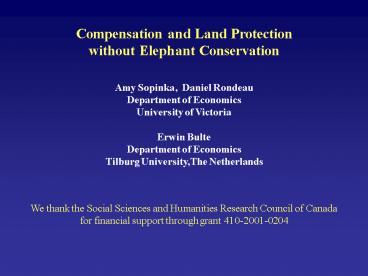Compensation and Land Protection PowerPoint PPT Presentation
1 / 24
Title: Compensation and Land Protection
1
Compensation and Land Protection without
Elephant Conservation Amy Sopinka, Daniel
Rondeau Department of Economics University of
Victoria Erwin Bulte Department of
Economics Tilburg University,The
Netherlands We thank the Social Sciences and
Humanities Research Council of Canada for
financial support through grant 410-2001-0204
2
General Background
3
General Background
4
General Background
5
Elephant Damage and Conflict
- Aggregate Crop Losses
- up to 25 of production
- Individual Crop Losses
- up to 70 of production
- 100 deaths to elephants in Kenya 1990 to 1993
6
Wildlife Damage Compensation Schemes
? Assess the physical quantity of crops
lost ? Multiply by market price ? Pay a
proportion d of losses in compensation
d100 for generous programs d more typically
10-30
? Implemented by Governments and NGOs (e.g. WWF,
WCS)
7
Government administered compensation programs
have not been very successful
- High transactions costs for affected farmers
- Grossly under funded
- Corruption and Fraud
8
- IUCN
- Compensation is not a long term solution
- Prevents the adoption of damage mitigation
measures that favor the long term coexistence of
humans and elephants
The compensation issue often overshadows
discussion of the many other measures that can be
used to mitigate human-wildlife conflict.
IUCN AfESG
9
Environmental NGOs are more enthusiastic
One of the simplest ways to mitigate conflict
without affecting elephant behavior or population
size is to compensate people for the damage they
have suffered or would have suffered had they not
protected their crops. WWF training manual
10
Rondeau and Bulte (2003)
- Theoretical Dynamic General Equilibrium model of
open access to land and wildlife stock in a small
rural economy
- Analyze the effects of compensating for wildlife
damage on land conversion, wildlife stock and
welfare
- Ambiguous results! Compensation may be
detrimental to wildlife and local welfare!
11
Objectives
- Assess the effectiveness of Elephant Damage
Compensation as an incentives-based instrument to
promote elephant conservation
- Challenge the role of habitat protection as a
conservation measure
- Applied numerical analysis based on Luangwa
Valley but primarily a conceptual exercise
12
Results (based on Luangwa Valley Calibration)
- With full compensation the elephant stock is on
average 1.7 to 4.5 higher than without
compensation
- Cyclical patterns (more elephants on some years
and fewer on others) with human population growth
- Cost of compensation is relatively high 2,913
to 3,317 USD (1984) per additional elephant per
year.
- Protected areas may precipitate stock extinction
13
Model Outline
- Open Access to Land (constrained by protected
areas) and Elephants (everywhere)
- Fixed Input Ratio (Leontief CRS) agricultural
production and elephant stock dependent damage
- Stock Density-based (rather than absolute stock)
Gordon-Scheaffer hunting production
- Exogenous prices for grains and elephant parts
- Variable human population growth allowed (but
exogenous)
14
Household Producers
Hunting Income
Farming Income
15
Calibration Luangwa Valley, Zambia
- Land Area considered 51,570 km2 16,660 km2 in
Parks - 77,151 people of productive age (9)
- Population growth 80s 3.7 90s 3.2
2000-15 1.7 - Value of Maize per km2 before damage and seed
costs 16,820 - Pre-Ivory Ban value of ivory/meat/hide per
elephant 302.54 - Post-Ivory Ban value of ivory/meat/hide per
elephant 273.54 - Elephant Population Dynamics and yield parameters
as per Milner-Gulland and Leader-Williams (1992)
study of Luangwa Valley elephant hunting,
adjusted for variable habitat size - Elephant stock 34,213 (1985) 12,109 (1994)
13,965 (1998) - Rate of Labor adjustment (2.51) and initial
agricultural land (7.4 of land base) estimated
to match evolution of the stock 1985-98
16
Model Runs
- Calibrated over 1985 1998
- Forecasted to 2003
- Policies analyzed from 2004 for up to 125 years
- Consider labor constraints, Protected Area
constraints, human population growth, ivory price
changes (from trade ban).
17
No Compensation No Human Pop. Growth
18
Full Compensation (d1) No Pop. Growth
19
No Compensation 1.7 annual pop growth
20
Year-to-Year Difference in Elephant Stock
(Compensation minus No Compensation) Population
Growth
21
Effectiveness of Compensation
22
Protected Areas as Constraints Growth
23
Protected Areas as Constraints No Growth
24
Final Thoughts and Caveats
- 1) Compensation is not a Panacea
- - Not particularly effective
- - Not Cheap (administrative costs not even
considered)
- Seen as constraints, Protected Areas can have
negative consequences on animal stocks unless
hunting bans are enforced
3) Other labor option(s) could prevent
extinction
4) Human population growth and migrations are
really endogenous to economic conditions -
Are reaction times fast enough to avoid
extinction? - Compensation triggers immigration
national level?
5) Incentives, regulations and their unintended
consequences!

